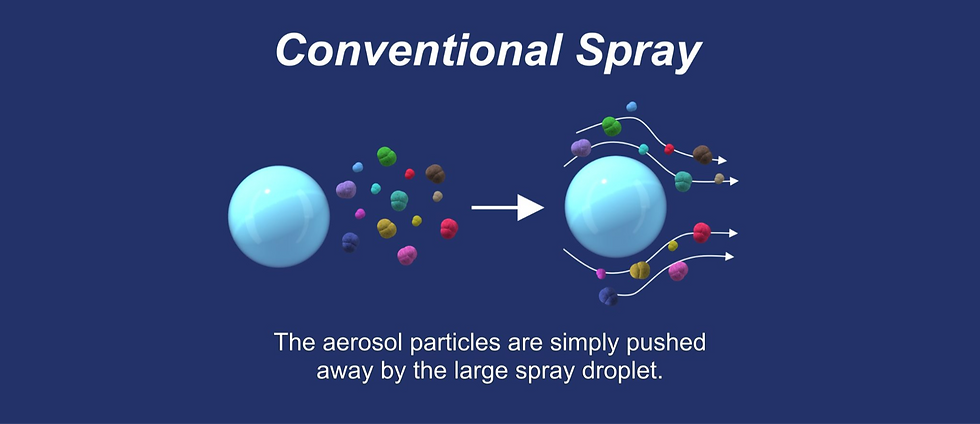Revolutionising Air Purification: The Science Behind NanoJet Technology for Cleaner Indoor Air
- Innova NanoJet Tech

- Aug 17
- 3 min read
Updated: Aug 19
In an era where air quality is increasingly under threat from pollutants, allergens, and airborne pathogens, NanoJet air purification offers an innovative and science-backed solution for cleaner indoor environments. People might assume they are safe from pollution indoors, yet the air inside homes, offices, or favourite cafés can still silently affect their health.. However, the air they breathe inside their home, office, or favourite café could be silently affecting their health. Indoor air can be up to 100 times more polluted than outdoor air (Wallace et al., 1986). It’s filled with things that cannot be seen—microscopic dust, allergens from furniture and carpets, harmful gases from cooking and cleaning products, and even airborne viruses and bacteria lingering long after someone sneezes or coughs.
These pollutants often go unnoticed until subtle symptoms arise—a slight fatigue, an occasional headache, or a sudden flare-up of allergies. But over time, prolonged exposure to these invisible threats can have serious consequences, contributing to respiratory issues, heart disease, and even cognitive impairments.
Traditional air purifiers, particularly those based on HEPA filtration, have long been the go-to option for improving indoor air quality. However, they come with inherent limitations in capturing ultra-fine particles, viruses, and bioaerosols. Focusing on cleaning the most challenging pollutants in the air, Innova NanoJet developed a groundbreaking solution—NanoJet technology—that is redefining air purification through advanced nano-scale droplet generation.
NanoJet Air Purification Technology: A Paradigm Shift in Allergy and Pathogen Removal
NanoJet technology revolutionises air purification by using ultra-fine nano-sized water droplets to interact with airborne contaminants. These droplets encapsulate pollutants, causing them to aggregate and become heavier, quickly removing them from the air. Unlike traditional filtration methods that passively trap particles, this active purification method works in real-time, drastically reducing pathogen presence within minutes.
How NanoJet Technology Works to Improve Indoor Air Quality


NanoJet technology generates trillions of ultra-fine nano-sized water droplets that collide with airborne contaminants like allergens, viruses, and bacteria. These droplets surround and encapsulate the pollutants, causing them to aggregate and gain mass. As a result, they fall out of the air almost instantly, improving air quality and making the environment more breathable within minutes.
Nano-sized droplets produced by NanoJet technology collide with and fully envelop suspended airborne viruses and pollutants, isolating and removing them from the air. For viruses and bacteria, this process can significantly mitigate their ability to interact with host cells. This isolation is crucial in inhibiting viral activity.
Experimental studies demonstrate that droplets of submicron size (~800 nm) significantly reduce particulate matter (PM1.0—including combustion particles, bacteria, and viruses) concentrations. In controlled chamber experiments, PM1.0 levels decreased by 30% within the first 30 minutes when exposed to submicron water droplets (Kim, Kim & Lee, 2021). This high efficacy is attributed to the size and dynamics of the droplets, which closely match the physical characteristics of ultrafine particulate matter, including viruses and bacteria. The combination of inertial collision and diffusion forces ensures that these droplets actively capture pathogens, encapsulating them to form aggregates that settle out of the air. Furthermore, the smaller droplet size substantially improves interaction rates, doubling removal efficiency compared to droplets with larger diameters (Kim & Lee, 2020). This physical encapsulation mechanism is a vital step in reducing pathogen viability, preventing transmission, and removing particulate matter in airborne environments.
Proven Effectiveness Against Airborne Pathogens and Allergens
Scientific validation of NanoJet technology has demonstrated superior efficacy in neutralising airborne contaminants. Third-party laboratory tests conducted at LMS Technologies show that the system removes over 98% of airborne MS2 virus within minutes of application. Unlike traditional air purifiers that rely on passive filtration over extended periods, NanoJet actively reduces exposure risks in real time.

Advantages Over Conventional Air Purifiers for Allergy Relief
Faster & More Effective: NanoJet technology removes airborne pathogens and allergens in minutes compared to hours with HEPA filters.
Filter-Free Operation: Eliminates costly and waste-generating filter replacements.
Active Neutralisation: Unlike passive filtration, NanoJet actively interacts with contaminants, removing them from the air.
Multi-Functionality: Acts as both an air purifier and humidity controller, reducing airborne allergens and improving overall indoor air quality.
Final Thoughts: The Future of Allergy-Friendly Air Purification is Here
The Innova NanoJet system represents a fundamental leap forward in air purification technology. By shifting from passive air filtration to active contaminant removal, it provides a faster, more efficient, and sustainable solution to modern air quality challenges. As air pollution, airborne diseases, and allergies continue to rise, embracing advanced technologies like NanoJet will be crucial in safeguarding indoor environments for homes, offices, healthcare facilities, and beyond.




Comments